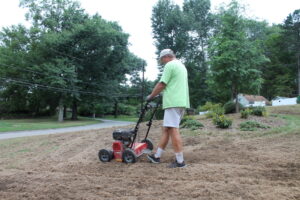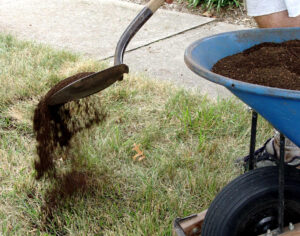Prime Time for All Things Lawn
September 10th, 2024
Whether you’re trying to start new grass or whip a sad lawn back into some semblance of decency, the weeks between Labor Day and early October are the year’s best.

This lawn could use a little attention.
The warm soil, cooling temperatures, and more frequent rain add up to ideal grass-seed sprouting (usually).
It’s also the perfect time to fertilize, which helps a lawn bounce back from the punishing hot, dry summer months.
And it’s prime time for a host of lawn-improvement jobs, including aerating, “top-dressing” with compost, and dethatching.
Here’s a rundown on what to do in three main lawn scenarios:
If you’re starting a new lawn…
Early fall follows late-summer sprouting with good conditions for young cool-season grasses to establish roots. Fall-started grass then has a second good growing season in spring before having to face its first main challenge of a hot, dry summer.
Grass grows best when it’s lightly tamped into loosened soil and then kept consistently damp until the seed is up and growing.
The five-step process:
1.) Test the soil. This tells you what kind and how much nutrition to add (if any) and also whether you need to adjust the acidity level of the soil (a pH between 6.5 and 7 is ideal).
Garden centers and county Extension offices have do-it-yourself Penn State soil-test kits for $10. Or get a kit online at Penn State’s soil test lab.
2.) Invest in quality seed. You’ll pay a little more, but grass varieties are available that perform far better than cheap seed against adversities such as drought, bugs, disease, and poor soil.
Penn State University’s findings on the best-performing grasses in Pennsylvania are posted on the National Turfgrass Evaluation Program’s website.
Read George’s article on how to pick the best grass seed
3.) Rough up and improve the soil. You can’t just toss grass seed on top of compacted ground and expect it to sprout.

This dethatcher machine is tearing up dead old turf and loosening the soil surface to prepare for new seed.
In small areas, a stiff rake is enough to loosen the soil to your goal of four to six inches. In larger areas, it’s worth renting a machine that loosens to that depth, such as a dethatcher (prongs that tear a few inches down into the soil) or a rototiller (rotating blades that dig six inches or deeper).
Even a core-aerator machine, which pulls finger-sized cores out of the soil with a rotating drum, is a viable option that creates openings for the seed.
If your soil is really bad, this is also the time to work in an inch or two of compost.
4.) Plant and cover. Scatter the seed over the loosened soil and lightly rake so that seeds are between one-quarter inch deep and at the surface. Tamp or roll so the seed is in good contact with the soil.
A light layer of straw or bagged newsprint mulch (specifically made and labeled for grass seeding) helps hold in moisture, lessens the chance of runoff in case of a heavy rain, and discourages birds from eating the seed. Use just enough to lightly cover the ground.
5.) Water, water, water. This is the key to the whole process. Keep the soil consistently damp or the seeds won’t sprout… or they’ll sprout and die if you let the ground go dry afterward.
You might need to dampen the surface as often as twice a day (morning and evening) in hot, dry weather until you see green.
Once the grass is up, check daily, and water whenever the surface is drying. You’ll need to water a little deeper but a little less often as the grass grows, right up until the ground freezes.
Stay off young grass as much as possible. Cut it for the first time when it’s long enough (about three inches) that the tips start to fall over.
Don’t worry about new weeds for now. You can deal with them next spring.
If you’re after the fastest results and don’t mind spending more, use sod instead of seed. Sod is carpet-like sections of already-growing grass, including a thin layer of soil. Pieces are butted and tamped into place, then kept watered to encourage the roots to penetrate into the soil.
If you’re trying to help a struggling lawn…
One of the best ways to point a struggling lawn in the right direction is by overseeding. This involves adding new seed to the existing lawn.

Seed has germinated nicely in this bare patch of lawn.
As with seeding virgin ground, you’ll have much better success if you can loosen or at least scratch up the soil surface before scattering seed.
A garden rake again is fine in small areas, while a core-aerator or dethatcher machine is good for larger areas. A tiller isn’t an option in this case since it would dig up and destroy any existing lawn you want to keep.
After disturbing the soil, scatter seed, lightly rake and tamp, then get busy with the same watering regimen as with a new lawn.
Another option for overseeding is a slit-seeder or “verticutter” machine. This piece of power equipment has rotating, vertical tines that slice into the soil surface in front of a hopper that deposits seed into the slices.
Overseeding works best when you first mow the lawn shorter than usual – to about one or two inches.
Watch George’s video on how to fix a ratty lawn
If you’re trying to keep an already-decent lawn in good shape…
Even if you’re not dealing with a bare or thin lawn, the post-Labor-Day weeks are good timing for most of the care jobs that go into maintaining a thick, green lawn.
Tops on that list is fertilizing.
Penn State professor of turfgrass science Dr. Peter Landschoot recommends that if you’re going to fertilize the lawn just once a year, early to mid-September is the best time to do it.
He says that timing promotes recovery from drought and heat-related injury, plus it’s a time that cool-season grasses manufacture and store carbohydrates.
The optimal fertilizer game plan for most Pennsylvania lawns, Landschoot says, includes three applications – once in mid to late spring, once in late summer, and once in late fall (before the ground freezes or before Dec. 15, whichever comes first to keep within Pennsylvania rules).
He recommends fertilizers that are high in slow-release nitrogen, such as natural organics and products made with IBDU technology. (Fertilizer bags spell out how much of their nitrogen comes from slow-release sources.)
To counteract compacted soil, late summer into early fall is the best time of year to use an aforementioned core-aerator machine. Its main purpose is to remove cores of soil and deposit them on the soil surface, which opens space for soil to spread out and aid grass-root growth.
Core aeration is best done on softened damp soil (not soggy, though) and when done with two or more passes in opposite directions.
If thatch (that spongy layer of dead roots and decaying organic matter between the soil and the base of grass blades) has built up to detrimental levels, another job possibility this time of year is running over the lawn with a dethatcher machine.
Unlike core aerators, dethatchers don’t penetrate inches into the soil but rather use rotating wire rippers that tear into the thatch and deposit it on the lawn. You’ll have lots of raking or bagging to do afterward.

Compost is being applied to a lawn in a process called “top-dressing.”
One other excellent September/October job is top-dressing the lawn. This involves raking a quarter-inch layer of compost or similar finely sifted organic matter over the existing turfgrass.
Top-dressing is a way to gradually add organic matter and nutrients to a lawn’s soil without having to dig up the whole thing and start over.
It also makes a good finishing touch to a lawn-overseeding project.
Read George’s season-long lawn-care plan for DIYers







